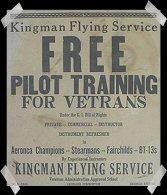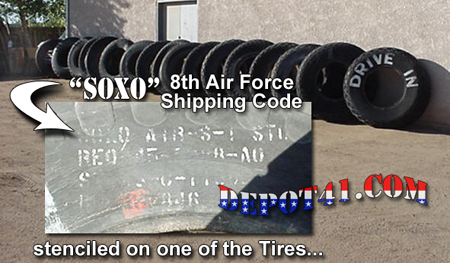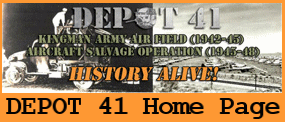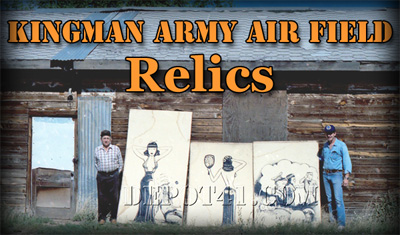
Circa 1986
George Steinke, KAAF paintings & me in front of the Base's relocated
Link Trainer Building
| And these are 'feathers' that were once fastened to a Link Trainer in the building above during WWII: | 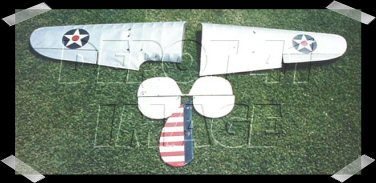 |
NOTE: the pre-War Insignia on each of the 5' silver wings, as well as the early tri-color striping on the rudder |
THE ART
Occasionally, military training could be exciting and often extremely dangerous,
but for the most part, mind numbing tedium was the order of the day.
It was left in the skilled hands of artists to lift spirits with colorful and often
humorous depictions of daily life.
The three extremely rare KAAF paintings shown at top were brushed onto wallboard,
perhaps in a dayroom, and they depict several cartoon subjects
that were very popular during the War:
Miss LACE & The WOLF (the latter on his keester after being socked by the former),
SAD SACK (in the mirror) and SNUFFY SMITH (having another one of his outlandish dreams!)
These are but a few of the precious Kingman Army Air Field paintings in the
Depot 41 Museum Collection
THE MAN
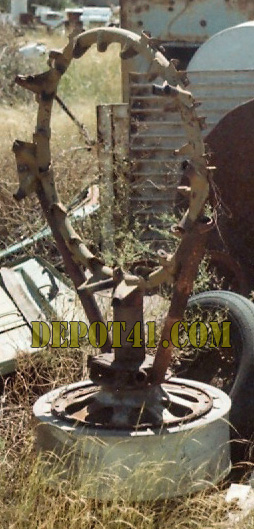 |
While he wasn't actually in the Armed Forces during WWII, he did live in Kingman through those hectic years and with his magical junkyard (where warbird aluminum & I made initial contact), his firsthand knowledge of what transpired at Kingman during the 40's and his unrivaled character | 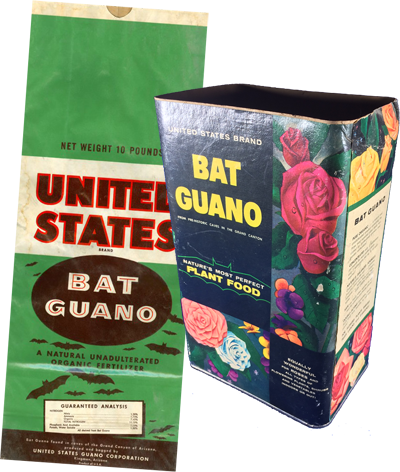 |
which, by the way, included a charming sense of humor,
George I. Steinke was not only the single most influential person
with regard to nearly every aspect of my Kingman involvement,
he remains one of the dearest friends I've ever had the pleasure of knowing.
Among his many accomplishments, during the late 40's George was instrumental
in convincing Mohave County to move their antiquated PORT KINGMAN operations
 |
 |
(with its outdated buildings & dirt runways) just a few miles further north on Hwy 66
in order to take advantage of the modern and recently-vacated Army Air Field.
|
George was also a co-owner of the post-War KINGMAN FLYING SERVICE which, among other things, provided "FREE PILOT TRAINING FOR VETRANS" [sic]. |
According to this vintage poster, their stable of planes included Aeronca Champions,
Stearmans, Fairchilds and BT-13s!
Always carrying his 1928 Pilot's Identification Card #1582, in 1991 George was deservingly inducted into the Arizona Aviation Hall of Fame. |
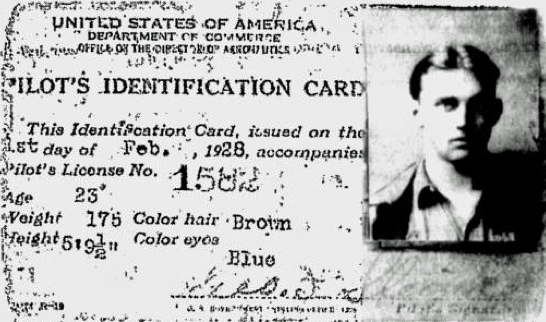 |
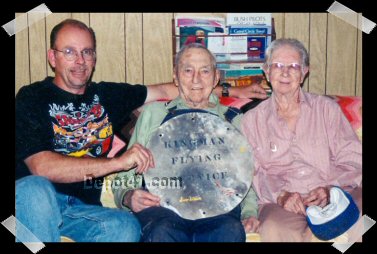 |
November 2001 A delighted George is seen here holding the old KINGMAN FLYING SERVICE sign that was once posted outside their business on Kingman Army Air Field - and yep, I got George to autograph it! (flanked by myself and his girlfriend Marge Meyers) |
| Picked from debris left over from the aircraft salvage operation, the 17" diameter, 3/32" thick ALCLAD disc has several holes that once fastened it to some unknown USAAF aircraft assembly - lacking a part number, its original function may never be known | 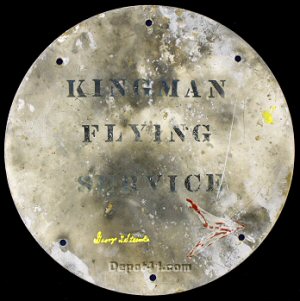 |
After living a life full of adventures, George passed away in August of 2002,
nearly reaching his 98th birthday.
Amongst all the Kingman Bomber artifacts in my shop is this tribute to George:
a pair of DH (maybe Curtiss Jenny?) biplane wheels plus a vintage propeller,
recalling the early days of aviation, of which he was such a big part!
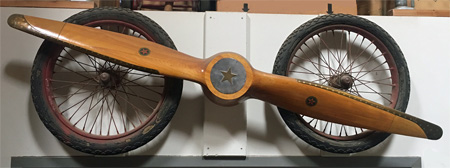
If you're wondering about the two side images at the start of George's information above, in the early 50s, he was involved with a bat guano mining operation in the southern portion of the Grand Canyon. For this, he fitted a shallow-draft barge with a surplus B-17 engine that swiveled on a B-17 wheel assembly for propulsion. The barge's original seat was directly behind the propellor and George once told me "It would take the hide off your face!" He then devised a tiller to one side of the R-1820 engine, which solved that problem. Unfortunately, the 'wheeled' engine mount was scrapped once George sold his yard in the early 90s.
George may be physically gone, but his indomitable spirit is with me daily
and there will definitely be more on him later.... JCS

Kingman Army Air Field Pics
(vintage)
Machine Shop under construction in 1942; the very same building the now-defunct Kingman Army Airfield Museum occupied for years, until they closed down in June of 2016 |
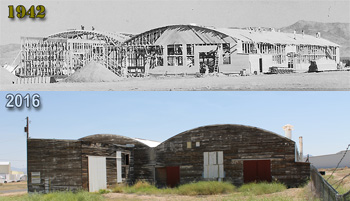 |
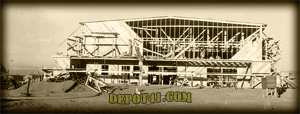 |
- January 1943: Base Theater under construction |
- 15 January 1943: The Waller Trainer buildings near completion |
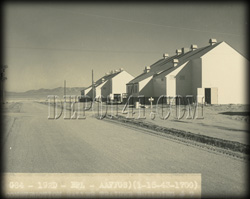 |
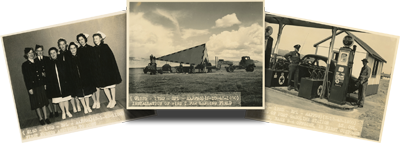
- 1 March 1943: FIRST NURSES ASSIGNED TO POST
- 10 MARCH 1943: INSTALLATION OF WIND T
- 13 MARCH 1943: OPENING OF POST GASOLINE STATION,
LT. COL. O. KEESE, BASE S-4 OFFICER, IS FIRST CUSTOMER
| - 27 March 1943: FIRST GUNNER'S GRADUATION RETREAT CEREMONY FOLLOWING EXERCISES |  |
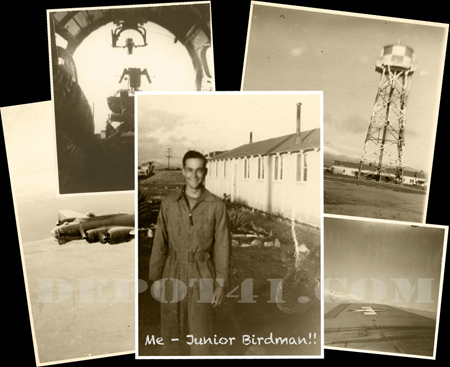 |
Of all the photographs Keith A. Lewis sent of his Kingman gunnery training, I especially like the portrait shot he labelled: "Me, Junior Birdman!!" |
Bob Hope and Crew packed a Kingman hangar |
 |
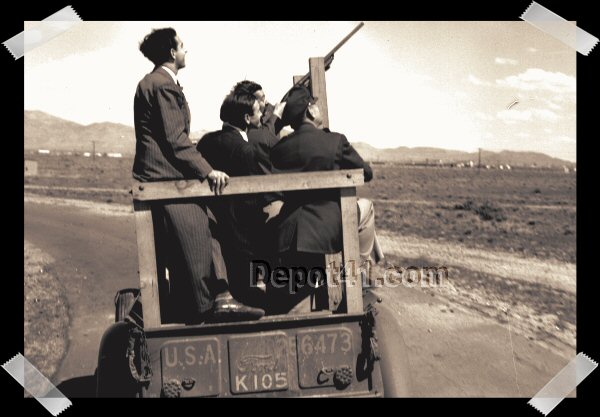 |
Jerry Colonna took time to give the Skeet Track a whirl |
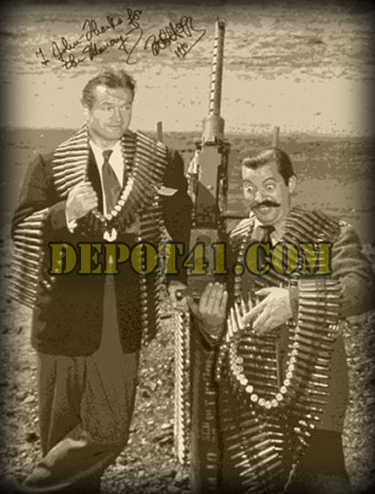
"To John - Thanks for the Memory,
Bob Hope"
And thanks for all you fellas did, Bob & Jerry!

Kingman Army Air Field Pics (modern)
The building that housed them long since gone, and reminiscent of England's Stonehenge, the mysterious pillars of KAAF's Waller Trainer screens were still standing proudly when I took this photo in 1978: Inset shows how the convex projection screen used for Gunnery Training was mounted on graduating concrete pillars. |
 |
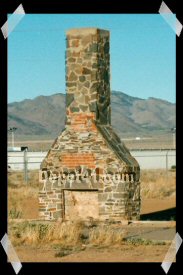 |
And here's my interesting 1995 shot of a well-built fireplace that stood for many decades in the Nurse's area. Subsequent commercial sprawl has long since obliterated both of these quaint pieces of KAAF history. |
Some of the many thousands of pieces of KAAF history that were saved by yours truly:
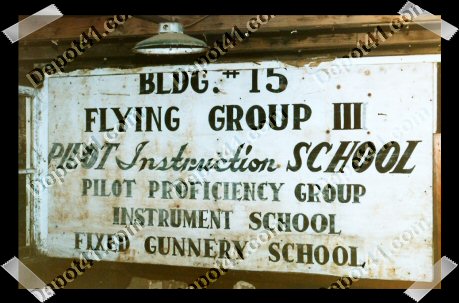 |
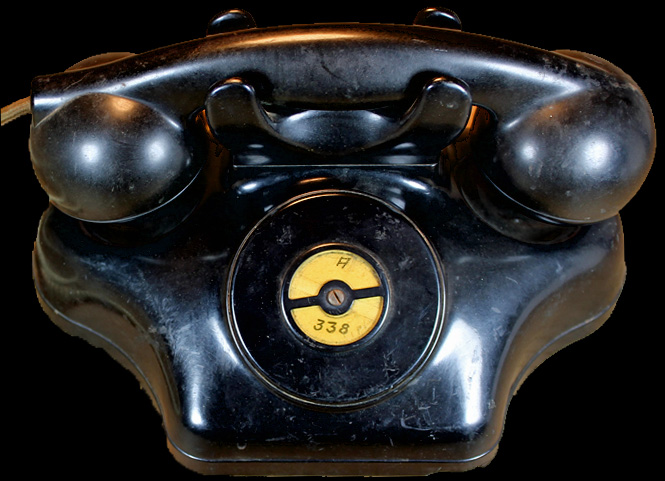 |
 |



Donated to the (now-defunct) Kingman Army Airfield Museum years ago by Frank & Doris Bonham,
this 6' airplane can opener was part of KAAF's Crash Truck equipment.
Possibly unique to the Base, it was used by several Firemen to puncture,
then rip open a fuselage in order to extract airmen.
The unusual artifact was purchased at KAAM's June 2016 going-out-of-business auction.
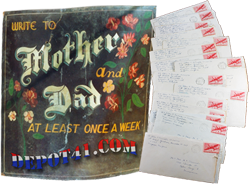
3-1/2' X 3-1/2' K.A.A.F. wallboard painting WRITE TO Mother and Dad AT LEAST ONCE A WEEK
and letters Alban F. Varnado wrote his folks while training at Kingman Army Air Field . . .
Alban graduated from Kingman's Gunnery School in 1944, then was sent to Hondo, Texas
for Navigational Training before being assigned to the 306th Bomb Group in England.
He passed away December 11, 2015 at the age of 94.
Flightline Fire Extinguishers were always at the ready; this KAAF example's last inspection date was 2-9-45 . . . and it remains fully-charged!
(Boeing/Seattle Factory Photo) |
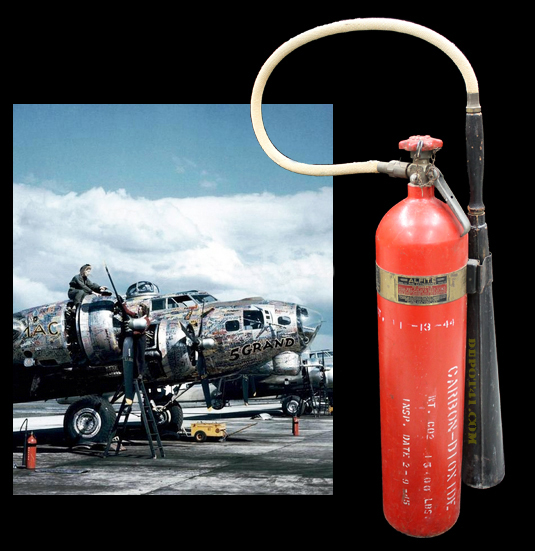 |
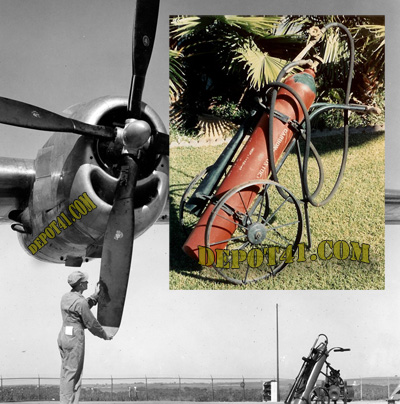 |
. . . As does this 75 lb. wheeled KAAF Extinguisher in the color inset (that has a 1-16-45 Inspection Date) A pair of 75 lb. flightline Extinguishers can be seen adjacent to the ground crewman rotating the propellor of a B-32 Dominator.
(Convair/Ft. Worth Factory Photo) |
BELOW . . .
Seventeen 56" Tires removed from Kingman Heavies and perhaps even Dominators - classified as VH (Very Heavy) bombers - that represent several WWII manufacturers:
...narrows it's bomber down to either a Flying Fortress or a Liberator! |
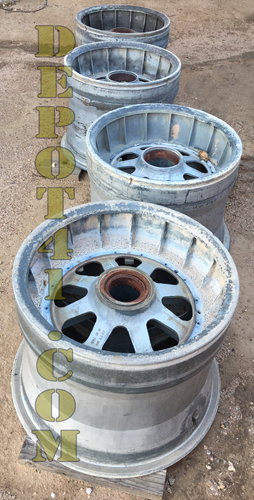 |
These Four Kingman Bomber Wheels could have come off B-17s, B-24s or even B-32s. George originally planned on building a large trailer using them, but as with us all, some projects become premanently sidelined! |

| And finally, a relatively contemporary photo of the KAAF theater remains some 60 years after the War, taken from about where the stage would have been: | 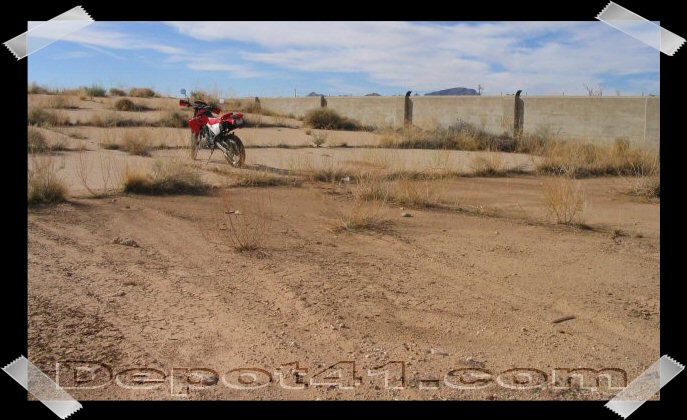 |
Tell me, is that music I hear above Arizona's perpetual wind, or only my mind playing tricks on me again?! |
photo credits this page:
George I. Steinke,
Frank Ellerbrook,
Keith A. Lewis,
Ed Stockton,
Vern and Maude Heaton,
Depot 41 Photo Archives
